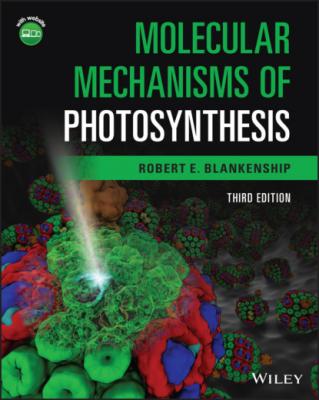Molecular Mechanisms of Photosynthesis. Robert E. Blankenship
Чтение книги онлайн.
Читать онлайн книгу Molecular Mechanisms of Photosynthesis - Robert E. Blankenship страница 16
 fission, producing two daughter cells.
fission, producing two daughter cells.
Eukaryotes, which are identical to the eukarya domain discussed earlier, are more sophisticated cells than prokaryotes. They are usually much larger than bacteria, up to hundreds of microns in size. In many cases, eukaryotic cells make up multicellular organisms, in which different cells are highly specialized or differentiated. Eukaryotic cells also contain a number of internal structures called organelles. These organelles are surrounded by membranes and include the nucleus, the mitochondrion, the endoplasmic reticulum, and, most importantly for photosynthesis, the chloroplast. At least two of these organelles, the mitochondrion and the chloroplast, have complex evolutionary histories, having been acquired by an early eukaryotic cell by a process called endosymbiosis (Margulis, 1993).
2.4 Metabolic patterns among living things
Organisms can also be classified according to their metabolic capabilities. While this method does not strictly follow evolutionary relationships, it is still very useful for understanding patterns of energy and metabolite flow, which is especially important in phototrophic organisms. A number of these patterns can be present simultaneously in a single organism, leading to names that are often intimidating. However, they are simply combinations of the individual metabolic patterns.
A fundamental metabolic distinction is between autotrophs and heterotrophs. The “troph” part is derived from a Greek word meaning “to feed” Autotrophs are “self‐feeding” organisms that derive all their cellular carbon from CO2, whereas heterotrophs are organisms that derive cellular carbon from organic carbon compounds. A second pattern relates to the source of energy for cellular processes. Phototrophs derive their energy from sunlight, whereas chemotrophs derive energy from various types of chemical compounds. If these compounds are organic chemicals, the organisms are chemoorganotrophs. If they are inorganic chemicals, they are called chemolithotrophs.
An organism that derives its energy from light and all its cellular carbon from CO2 is known as a photoautotroph. Most photosynthetic organisms can grow in this manner. If the organism grows by using light as an energy source, but assimilates organic carbon, it is known as a photoheterotroph. Many phototrophic organisms can also grow in this way, and in a large number of cases, a single organism can grow either photoautotrophically or photoheterotrophically, depending on the availability of organic matter. Table 2.1 summarizes some of the metabolic relationships among living organisms.
Table 2.1 Metabolic patterns in living organisms
| Type of organism | Metabolic characteristics |
| Autotroph | Organism that is capable of living on CO2 as sole carbon source |
| Heterotroph | Organism that uses organic carbon as carbon source |
| Phototroph | Organism that uses light as source of energy |
| Chemotroph | Organism that uses chemicals as energy sources |
| Photoautotroph | Organism that uses light as source of energy and CO2 as sole carbon source |
| Photoheterotroph | Organism that uses light as source of energy and organic compounds as carbon source |
| Chemoorganotroph | Organism that obtains energetic needs from organic compounds |
| Chemolithotroph | Organism that obtains energetic needs from inorganic compounds |
| Chemolithoheterotroph | Organism that obtains energetic needs from inorganic compounds and uses organic compounds as carbon source |
| Chemolithoautotroph | Organism that obtains energetic needs from inorganic compounds and uses CO2 as sole carbon source |
Oxygen is central to the metabolism of most cells. If an organism is capable of growing in the presence of oxygen, it is classed as an aerobe. If it cannot grow in the presence of oxygen, it is called an anaerobe. Some organisms can switch back and forth from aerobic and anaerobic metabolisms and are call facultative aerobes. In most cases, aerobes utilize organic molecules as electron donors and O2 as an electron acceptor in a process called aerobic respiration. Other inorganic compounds can sometimes serve as electron acceptors, a process known as anaerobic respiration. Finally, organisms that use organic compounds as both electron donors and acceptors in the absence of oxygen live by carrying out fermentation.
2.5 Phototrophic prokaryotes
There are seven distinct major groups, or phyla, of bacteria that are capable of photosynthesis (Hohmann‐Marriott and Blankenship, 2012; Thiel et al., 2018). Six of these are anoxygenic, in that they do not produce molecular oxygen as a by‐product of photosynthesis (Blankenship et al., 1995). These anoxygenic phototrophic bacteria include the purple bacteria, the green sulfur bacteria, the filamentous anoxygenic phototrophs (FAP), formerly known as green nonsulfur bacteria, the heliobacteria, the chloroacidobacteria, and the gemmatimonadetes. Each will be introduced briefly below. The single oxygen‐evolving, or oxygenic, group of photosynthetic bacteria is the cyanobacteria (Bryant, 1994). Each of these groups is a relatively coherent collection of organisms with many similar properties in the pigments they contain and the way they carry out photosynthesis. The groups have been established over many years and are based on a number of characteristics, including pigment composition and metabolic capabilities. Fortunately, these groups are also generally similar to those revealed by the rRNA classification method discussed above. Figure 2.2 illustrates schematically the molecular complexes and metabolisms found in each of the phyla of anoxygenic phototrophic prokaryotes (left panel) and oxygenic photosynthetic organisms (right panel)
.
Figure 2.2 Photosynthetic machinery and electron transport of photosynthetic organisms, including a description of photosynthetic complexes. Left panel: anoxygenic phototrophs; right panel: oxygenic photosynthetic organisms.
Source: Courtesy of Martin Hohmann‐Marriott.
2.5.1 Purple bacteria
Purple bacteria are anoxygenic phototrophs that are extremely versatile metabolically (Hunter et al., 2009 and refs.